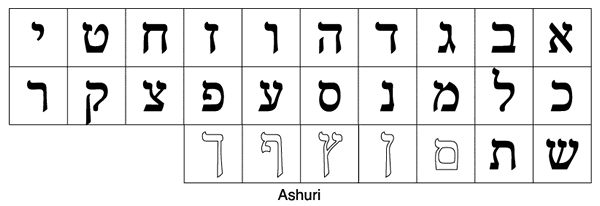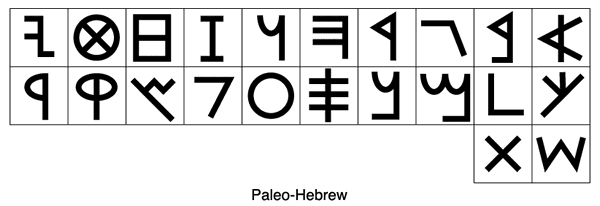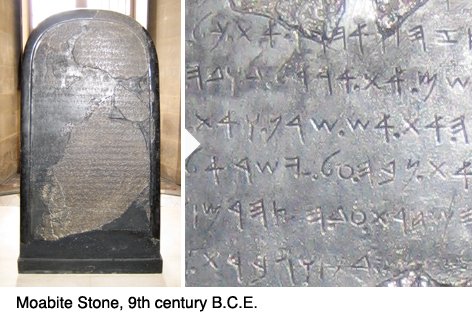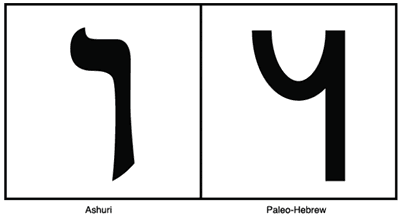Guest Post by Chaim Clorfene of Tzfas
Paleo-Hebrew
By Chaim Clorfene
Rediscovering a lost Jewish script
There is one Hebrew language, but it has two different scripts. One of these scripts fell into complete disuse and was forgotten 2000 years ago. Within the past century, it has been rediscovered. The impact of this discovery has not yet been fully felt, for the lost script may well be the original, the one in which the Ten Commandments were written by the finger of G-d1 and the one in which Moses wrote the original Torah.
The lost script is called Ivri or Paleo-Hebrew. Our familiar Hebrew script is known as Ashuri2 or Assyrian script.


Paleo-Hebrew was completely abandoned around the time of the destruction of the Second Temple in the year 70 C.E. Except for the inscriptions on a few ancient Jewish coins, no remnant of Paleo-Hebrew remained. The Babylonian Talmud (Sanhedrin 21b) has a pertinent discussion about these two forms of Hebrew writing:
Mar Zutra3 or, some say, Mar Ukba said: Originally the Torah was given to Israel in Ivri (Paleo-Hebrew) letters and in the sacred Hebrew language. Later, in the times of Ezra,4 the Torah was given in Ashuri script and Aramaic language. Finally, they selected for Israel the Ashuri script and Hebrew language, leaving the original Hebrew5 characters and Aramaic language for the ignorant people. Rebbe Yose said: Why is it called Ashuri (Assyrian) script? Because they brought it with them from Assyria.6
This opinion coincides with the findings of modern archeologists, who maintain that around the year 1800 B.C.E., Egyptian hieroglyphics had inspired Phoenicians living and working in Egypt to develop Proto-Canaanite, a phonetic alphabet. Proto-Canaanite then evolved as Paleo-Hebrew and was the script used by all the peoples of the Middle East, including the Phoenicians, the Canaanites, the Moabites, and also the Hebrews. Archeologists have unearthed Paleo-Hebrew inscriptions on stone and pottery dating as far back as the twelfth century B.C.E.

Around the year 800 B.C.E., Paleo-Hebrew letters became reworked in Babylon and the surrounding region8 and evolved as the native Aramaic script. Around 275 years later (circa 525 B.C.E.) the Jews in Babylon, notably Ezra the Scribe, refined the native Aramaic letters and developed Ashuri, the script recognized today as Hebrew.
Throughout the Second Temple period, Ashuri was the dominant script used for all holy and secular purposes. However, Paleo-Hebrew was not entirely forgotten and appears on some coins of the period.9 The last known remnant of Paleo-Hebrew writing appears on Bar Kochba coins, circa 125 C.E. The use of Paleo-Hebrew letters on these coins is of great significance.
Bar Kochba10 led the last revolt against Rome 50 years after the Second Temple had been destroyed. Rabbi Akiva considered him to be the Messiah. Bar Kochba minted his own coins by over-striking them on existing Roman coins. This was symbolic of his rebellion against Rome. He inscribed three Paleo-Hebrew letters, yud-hay-dalet, Yehud, "Judea," on the face of his coins. His choice of Paleo-Hebrew letters was a daring statement of return to the original Jewish script that was used before the Jews had been subjugated by foreign powers.11
After the Bar Kochba rebellion was put down, Paleo-Hebrew fell into complete disuse. It became the original dead letter. Were it not for the above mentioned discussion in the Talmud, Paleo-Hebrew would have been completely forgotten. It is virtually certain that no one could read it, since no documents or samples of its letters survived, except for those three letters on the Bar Kocha coins.12
In the 20th century, everything changed. Archeologists began discovering buried artifacts inscribed with Paleo-Hebrew letters dating back to the times of King David and earlier.13 And then the Dead Sea Scrolls were found with several examples of Paleo-Hebrew text. The ancient Hebrew alphabet had been resurrected from the dead.
The second opinion in the Talmud differs radically from that of Mar Zutra:
Rabbi Yehuda the Prince14 said: The Torah was originally given to Israel in Ashuri script,15but when they sinned,16 it was changed to Ivri.17 And when they repented,18 Ashuri was returned to them, as it is written:19 "Return to Zion, you prisoners of hope, and even today I declare that I will return the secondary teachings to you.20" And why was it called Ashuri? Because its form is straight (me'ushar).
This opinion remains completely outside the scope archeological evidence. According to rabbinic tradition, Adam and Eve spoke Hebrew and read and wrote Ashuri script. For nearly 2000 years, this was the world's only language, as it says (Gen. 11:1). "The whole earth was of one language with one form of words." Then came the Tower of Babel. Unified in speech and purpose, the people proposed to build a tower "with its top in heaven." This is interpreted to mean that they wanted to build a great edifice with a temple of idol worship at its top to "wage spiritual war against G-d." As a pre-emptive act, G-d confused their language and scattered the people all over the world.21 According to Biblical scholars, the date was 1930 B.C.E.
Before the episode of the Tower of Babel, there was a righteous man named Ashur who foresaw the danger and fled from the area to build the cities of Nineveh, Rehovot and Calah.22 Having abandoned the region before the building of the Tower of Babel, Ashur was excluded from punishment and retained the original holy language and its script. Thus, it became known as Ashuri. Over the next millennium, the holy script of Ashuri deteriorated and became mixed with the script of the indigenous peoples who wrote in Paleo-Hebrew. The downgraded writing finally emerged as Aramaic script somewhere around 800 B.C.E.
But, according to tradition, there was one family chosen by G-d to retain the original holy tongue and its script, the family of Shem, one of the three sons of Noah. Through this family and its descendants, Abraham, Isaac, and Jacob, the holy tongue and the original Ashuri script were carefully preserved. This Talmudic view asserts that during their bondage in Egypt, the Children of Israel remained faithful to Ashuri, their ancestral language and script. Thus, the Torah was given in the Ashuri script. The year was 1480 B.C.E.
After the Jews entered the land of Canaan, they were exposed to the Ivri writing of the peoples around them, and they began to read and write it alongside their holy Ashuri letters. This is similar to Jews today in the United States and England who read and write English as well as Hebrew. Accordingly, all Torah scrolls were written in Ashuri script from the time of Mount Sinai until around 150 years before the destruction of Solomon's Temple, a period of approximately 750 years.
At this juncture in history, King Menasseh23 embraced idolatry and plotted to destroy the Torah and its leadership. He murdered the prophet Isaiah, his maternal grandfather, and caused the blood of religious Jews to flow like a river through Jerusalem. It is logical to presume that he also confiscated all the Torah scrolls he could find, which according to Rebbe Yehuda were written inAshuri, and burned or buried them. At that point, the Jewish scribes would have had the opportunity to begin writing the Torah in Ivri, the common script of the region.
Finally, during the days of Mordecai and Esther,24 with the Jews in exile in Babylon and Persia, Ezra wrote a Torah in the original Ashuri script. Torah scrolls were copied from Ezra's Torah, and all successive Torah scrolls were copied from those, right down to our very day.
The Talmud now offers a third opinion:
Rabbi Simeon ben Elazar25 said in the name of Rabbi Eliezer ben Parta, who said in the name of Rabbi Elazar of Modin: This writing of the Torah [Ashuri] was never changed, for it is written: "The vavei ha-amudim (the hooks of the pillars).26" Just as the word 'pillar' (amud in Hebrew) has not changed, neither has the form of the 'vav.' Also it is written,27 "And unto the Jews, according to their script and language." Just as their language did not change, neither did their writing.
This opinion argues that the Torah has always been written in Ashuri script and never in Ivri. Rabbi Elazar offers two proofs based on logic:
The first proof is that the word for hook in the Torah written by Moses was 'vav.' Vav is also the name of the sixth letter of the Hebrew alef-bet, which is shaped like a hook in Ashuri. Since thevav in Rabbi Elazar's day28 was still shaped like a hook, and his Torah was written in Ashuri, he concludes that the script of the Torah was always Ashuri. However, his logic is shown to be flawed, since the letter vav in Ivri (Paleo-Hebrew) also resembles a hook.29 In fact, the vav ofIvri may resemble a hook more than the vav of Ashuri.

Rabbi Elazar's second proof is a verse in the Book of Esther, where Mordecai sends letters to the Jews throughout the kingdom, written in their "script and language." The contention is that the words "script and language" are written together and are equivalent. Rabbi Elazar reasons that the Jews did not change their language in the days of Mordecai, therefore, they also did not change their script, which was Ashuri.
Again, his argument does not hold up, for the fact is that the Jews did change their language in the days of Mordecai. The Book of Daniel, written during that same period was written in Aramaic, not Hebrew. Why did Daniel choose Aramaic? Because Aramaic had replaced Hebrew as the language of the Jews, and it remained the primary spoken language of the Jewish people for the next millennium.
Since both proofs offered by Rabbi Elazar are rejected, we are left with two views:
1.) The Torah was originally written by Moses in Paleo-Hebrew (Ivri). It was changed to Ashuriscript by Ezra during the Babylonian Exile and has remained so ever since.
2.) The Torah was written by Moses in Ashuri script. It was changed to Ivri towards the end of the First Temple period and then changed back again to Ashuri by Ezra.
This discussion is of monumental significance since it includes the writing of the Ten Commandments, "the two Tablets of Testimony, stone tablets inscribed by the finger of G-d."30The Jerusalem Talmud31 maintains that the Ten Commandments were written in Ivri. The Babylonian Talmud32 says that they were written in Ashuri.
In the end, we find that the Talmudic discussion leaves us with a doubt concerning which script was the original. But we can possibly resolve this by considering a ceremony performed with the Kohen Gadol (High Priest) and the kings of the House of David.
The Mishna33 tells us that the Kohen Gadol must be consecrated by anointing with shemenhamischa, the anointing oil made by Moses. This is one of the 613 commandments of the Torah. A small amount of the oil is poured on the High Priest's head and applied between his eyes by a finger drawing the form of an X, the letter Tav, the 22nd letter of the Alef-Bet in Ivri script. And when the kings of the Davidic dynasty are anointed, the same oil is used, but applied in the shape of a crown, the vertical zigzag lines of a W, the form of the letter Shin, the 21st letter of Ivri script.34 Neither of these two shapes is found in our familiar Ashuri script.
Since Aaron, the High Priest, and King David appear to have been anointed with forms of letters ofIvri script, we can presume that Ivri was the script used during the early generations of the Children of Israel,35 and that Ashuri script was developed later. According to the opinion of Mar Zutra, it was a thousand years later during the Babylonian Exile.
My personal reflection on this subject is to avoid the mistake of thinking that if Paleo-Hebrew was the original, then it must be the holier of the two scripts. The fact is that Ezra, the father of Ashuriscript, was the author of three books of the Hebrew Scriptures36 and worked with ruach hakodesh,37 a form of prophecy. The Hebrew letters that came from his hand contain some of the deepest and most mystical teachings of the Torah. These letters have sustained the Jewish people for 2500 years and will undoubtedly continue to do so in the future. But at the very least, the re-discovery of Ivri or Paleo-Hebrew suggests that we live in a new era, one that is struggling to synthesize the past with the present so as to become greater than both.
1 Exodus 31:18.
2 Technically, the correct terms are Ktav Ivri, Hebrew writing, and Ktav Ashuri, Assyrian writing.
3 He passed away circa 414 C.E. Mar Zutra was a pious leader (Reish Galuta or Exilarch) of the Jewish community in Babylon. His opinions are cited frequently in the Talmud.
4 Ezra the Scribe, generally acknowledged as the leader of the generation towards the end of the Babylonian Exile.
5 Paleo-Hebrew or Ivri.
6 When the Jews returned to Israel to build the Second Temple, they brought this script with them from Babylon, here referred to as Assyria, as it is similarly called in Jeremiah 2:18 and Ezra 6:22. Today, northern Iraq comprises the ancient land of Assyria and southern Iraq is Babylon.
7 Phonetic letters represent the sounds of speech. Logograms, such as Chinese writing and Egyptian hieroglyphics, represent entire words or concepts. The Proto-Canaanite alphabet was considered a great innovation, for previous scripts were logographic.
8 Ancient Babylon was approximately 350 kilometers northeast of Israel.
9 Examples of Paleo-Hebrew have also been discovered in the Dead Sea Scrolls where the Four Letter Name of G-d (YHWH) was found written in this script. Besides the Dead Sea Scrolls and coins of the era, no trace of Paleo-Hebrew has been found from the Second Temple period.
10 His proper name was Simon ben Koziba, and was called Bar Kochba, which means the son in whom there is power.
11 Nebuchadnezzar, King of Babylon, had conquered the Jews and destroyed the First Temple. And when the people returned to Israel during the Second Temple period, they were under the rule of Persia, then Greece, and finally Rome. Israel's independent sovereignty during the Second Commonwealth lasted for only seventeen years during the reign of the Hasmonean kings.
12 It is known that the Ramban, Rabbi Moses ben Nachman, a 13th century scholar, had a Bar Kochba coin in his possession. No other examples of Paleo-Hebrew letters are known to have existed at any time or place in the diaspora.
13 Notably the Gezer calendar and the Mesha stele (Moabite stone).
14 Rabbi Yehuda the Prince (Rebbe) was the rabbinic leader in Israel after the defeat of Bar Kochba, circa 150-200 C.E.. He and his Bet Din (Ecclesiastic Court) put the oral tradition of theMishna into writing and unified the halacha (Jewish law), in effect establishing what we know today as Orthodox Judaism.
15 The words 'this Ashuri script' are used because it was the only script used in Rabbi Yehuda's generation.
16 Towards the end of the First Temple period in the days of Menashe (Menasseh), the king of Judah.
17 Paleo-Hebrew. Rebbe uses the word ro'etz, meaning broken letters, similar to a word found inIsaiah 42:3. He was contrasting the stick-like form of Paleo-Hebrew (Ivri) to the more beautiful, flowing form of Ashuri letters.
18 During the days of Mordecai and Esther towards the end of the Babylonian Exile.
19 Zechariah 9:12
20 According to Rebbe, this verse indicated that if the Jewish people repented, Ashuri script, which had become secondary, would be returned.
21 Genesis 11:9.
22 Genesis 10:11.
23 He was king of Judea for 55 years, circa 700-645 B.C.E. In II Chronicles 33:3, it relates that he built altars to the Baal and Ashteroth and worshipped all the host of heaven.
24 Circa 525 B.C.E.
25 Second century rabbi and contemporary of Judah the Prince.
26 Exodus 27:10. The verse refers to the courtyard of the Mishkan (Tabernacle). This courtyard had a surrounding curtain which was attached to pillars by means of hooks affixed to the pillars.
27 Esther 8:9. This refers to letters sent by Mordecai to various nationalities throughout the kingdom, including the Jews in 'their script and language.'
28 In the second century C.E., approximately 1750 years after Moses wrote the first Torah.
29 It is a virtual certainty that Rabbi Elazar never saw an Ivri vav, inasmuch as Ivri had become extinct at least one hundred years before he was born.
30 Exodus 31:18.
31 Jerusalem Talmud, Megilla 10b.
32 Babylonian Talmud, Shabbat 104a.
33 Menachot 6:3 and found later in Mishneh Torah, Sefer Avodah, Laws of Vessels of the Temple 1:9.
34 The Mishna does not mention these Ivri letters by name, for by the time of the writing of theMishna, approximately 180 C.E., Ivri script had been completely forgotten. The Mishna describes the symbol marked in oil on the High Priest's head as a Greek letter, Chi, the shape of an 'x,' (the same shape as the Ivri letter tav). During that period, Greek had become a dominant language of the region, even in Israel.
35 King David was born 450 years prior to the Babylonian exile, and Aaron the High Priest was born nearly 550 years before David.
36 The Book of Ezra and Chronicles I and II.
37 Often translated as the holy spirit, but more correctly meaning the spirit of holiness or divine inspiration.
Chaim Clorfene is the director of Shaar Hamikdash, Third Temple museum, research and learning center in Tsfat (Safed), Israel, and is the author of The Messianic Temple. His book is available at www.thirdtempleworld.com





 Posted in:
Posted in: 





3 comments :
hm, major paradigm shift. B"H
Is this authentic?
http://www.wnd.com/?pageId=129385
Here is an article from Biblical Archaeology Review about the 'birth of the alphabet' that you may find interesting.
http://www.bib-arch.org/bar/article.asp?PubID=BSBA&Volume=36&Issue=02&ArticleID=06&Page=0
Post a Comment
Note: Only a member of this blog may post a comment.